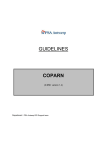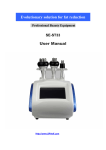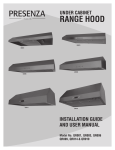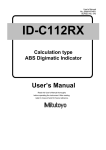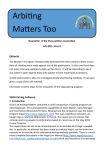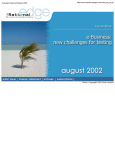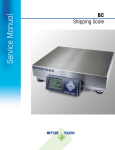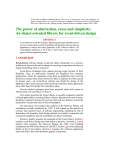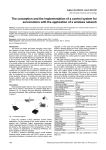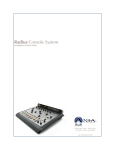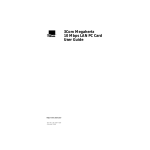Download LogiGear Magazine - August 2014_Final.pub
Transcript
SHOWCASING THOUGHT LEADERSHIP AND ADVANCES IN SOFTWARE TESTING
Testing Embedded Systems
and the
Internet of Things
Software Testing’s New
Frontier
Michael Hackett, LogiGear Corporation
Testing Strategy
for the IOT
Jon Hagar
Why you Need a
Software Specific Test
Plan
Proven Practices for
Testing Embedded
Software
Philip Koopman
Andrey Pronin
August 2014 | Volume VIII | Issue 3
Letter from the Editor
2
Testing Embedded systems and testing the Internet of
Things could each have their own issue of LogiGear
magazine. But these days they are referred to presupposing knowledge of the other, so we thought it a good
idea to tackle the two together in this issue to give a
broad understanding of the landscape as well as help
you get started testing smarter and more informed.
Editor in Chief
Michael Hackett
Managing Editor
Brian Letwin
Deputy Editor
Joe Luthy
Worldwide Offices
United States Headquarters
4100 E 3rd Ave, Ste 150
Foster City, CA 94404
Tel +01 650 572 1400
Fax +01 650 572 2822
Viet Nam Headquarters
1A Phan Xich Long, Ward 2
Phu Nhuan District
Ho Chi Minh City
Tel +84 8 3995 4072
Fax +84 8 3995 4076
Viet Nam, Da Nang
VNPT Tower, F/l 7 & 8
346 Street 2/9
Hai Chau District
Da Nang
Tel +84 511 3655 33
www.LogiGear.com
www.LogiGear.vn
www.LogiGearmagazine.com
Copyright 2014
LogiGear Corporation
All rights reserved.
Reproduction without permission is prohibited.
Submission guidelines are located at
http://www.LogiGear.com/magazine/
issue/news/editorial-calendar-andsubmission-guidelines/
The Internet of Things (IoT) is getting more and more
press and attention every day. There is nothing new
about the idea, everyone knew it was "the future." But that future is here. Efficient wireless protocols, sensors to sense everything, and cheaper processors
are making the future now. The number of things with embedded systems is
already staggering, and it’s estimated there will be tens of billions of embedded
system devices connected by 2020.
Although often used interchangeably, embedded systems are not equal to the
IoT. The difference is that embedded systems do not have to be connected to
anything while the things in the IoT are connected via the internet. Devices now
do things like monitor your glucose level and send a constant stream of data to
your doctor. Others count the steps you take, your refrigerator can order milk
when the carton is near-empty. and self-driving cars are in prototype.
My early embedded systems testing experience focused on medical device testing and mobile communication/mobile phone testing. In each case, as is common with embedded systems, the functionality was important but very limited,
the UI was very limited or non-existent. The testing started with validating requirements. We then made models of expected behaviors and tested as thoroughly as we had time to do.
The IoT is a big leap ahead from closed system embedded devices with limited
functionality and no connectivity. Even for embedded system experienced testers connectivity is a big change. There are potentially large data being produced,
connection to other devices and APIs to other services. This opens the door to
such things as interoperability, security and performance issues not normally
seen in embedded system testing. All with speed of delivery demands in an industry with few and often competing standards.
As is always the case with new or more pervasive technologies: how do you test
it? What are the new testing concerns? What skills do you have to learn to respond to this staggering growth? That is what this issue begins to explore.
In this issue I discuss the landscape of the Internet of Things with Joe Luthy; Jon
Hagar gives expert recommendations for testing the IoT; I explain new areas for
traditional testers working in the IoT; Phillip Koopman suggests that those performing embedded testing have software specific test plan; Auriga’s Andrey Pronin writes about the importance of a highly organized testing process and Essensium/Mind’s Arnout Vandecappelle reminds us that team collaboration is
essential for testing embedded systems. Welcome to the IoT.
WWW.LOGIGEARMAGAZINE.COM
AUGUST 2014 ǀ VOL VIII ǀ ISSUE 3
3
In this Issue
4 IN THE NEWS
5
INTERVIEW WITH
MICHA EL HACKET:
THE IOT LANDSCAPE
23
Andrey Pronin, Auriga
Michael Hackett and Joe Luthy,
LogiGear Corporation
Quick start understanding of the
Internet of Things from a development team perspective
Build the right test platform including infrastructure, virtual lab and process
30
10 TESTING STRATEGY
Jon Hagar
15 S O F T W A R E T E S T I N G ’ S
NEW FRONTIER
Michael Hackett, LogiGear
TEAM BASED TESTING
Arnout Vandecappelle, Essensium/Mind
FOR THE IOT
Experience report: A guide through
the challenges and risks of testing
the IoT
PROVEN PRACTICES FOR
TESTING EMBEDDED
SOFTWARE
Getting everyone involved lets you shorten
the loop by testing early
34
GLOSSARY
Some of the terms used when discussing
testing embedded systems
What you need to know for testing
in the new paradigm
21 BLOGGER OF THE
MONTH: WHY YOU
NEED A SOFTWARE
SPECIFIC TEST PLAN
Phillip Koopman
Experience-based recommendations to test the brains that drive
the devices
WWW.LOGIGEARMAGAZINE.COM
AUGUST 2014 ǀ VOL VIII ǀ ISSUE 3
4
In the News
Agile Testers Must Develop New Mindset: Janet Gregory
Testers have a vital role to play in the agile world, but in order to
do so, they need to develop a distinct mindset. Speaking at a
workshop hosted by IndigoCube, Janet Gregory, a leading international expert in agile testing, outlined the characteristics of an
agile tester.
"The agile tester no longer sees herself as someone whose main
purpose is to identify bugs or ensure that specific requirements
are met. Agile testers are thinkers and take a much broader
view, asking: ‘What can I do to help deliver the software successfully?' says Gregory.
"The ideal agile tester is analytical, curious, observant and critical – and combines a wide cross-functional knowledge with deep
skills in the discipline of testing."
Maersk Begins Software Testing on Five Vessels
Global container shipping company Maersk Line has started pilot testing of a maritime software tool, ShipManager,
on five of its vessels.
Norway-based shipping classification society DNV GL has
developed the software, which is said to deliver increased
process efficiency and improved access to and analysis of
information.
Maersk Line has selected the application as the preferred
solution over 26 other ship management platforms for installation onto its self-owned fleet of 250 vessels in 2015.
150 Jobs Coming to South Bronx at Software Testing Center
A piece of Silicon Alley is coming to The Bronx. An IT job
training nonprofit plans to open a massive software testing center in Port Morris this fall that will bring 150 jobs to
the area.
Per Scholas, which is based in The Bronx, and the IT consulting company Doran Jones plan to open the roughly $1
million, three-story, 90,000-square-foot software testing
center at 804 E. 138th St., near Willow Avenue.
Starting wages for the jobs will be $35,000 with benefits,
and 80 percent of hires will be Per Scholas graduates.
"A lot of folks who are based in the community will actually get access to the jobs, which they wouldn’t
ordinarily," said Co-CEO Keith Klain.
WWW.LOGIGEARMAGAZINE.COM
AUGUST 2014 ǀ VOL VIII ǀ ISSUE 3
5
Feature
An Interview with Michael Hackett
Quick start understanding of the Internet of Things from a development team perspective
By Joe Luthy, LogiGear Corporation
W
hen I hear the word internet I tend to
think about information, interaction
and communication as it relates to
people using and controlling all sorts of devices,
but it’s much more dynamic than that. More and
more, devices, computers and even interconnected computer systems are interacting and
communicating with each other to assist us humans, and in a lot of cases, control our activity.
The Internet of Things (IoT) is drastically changing the traditional view of the internet.
MH: Embedded systems are the foundation of
the IoT. Embedded devices and systems have
been around for a very long time—since the beginning of computers. It is widely believed the
first internet appliance or first thing in the IoT
went online in 1982, the Networked Coke Machine. Four students at Carnegie Mellon University used a sensor to find out remotely if a coke
machine had coke or was empty – sounds super
simple by today’s standards. It was 30 years ago.
An embedded device could simply be a chip in a
small system or a very, very large system with a
For this article I sat down with Michael Hackett
narrow scope of specific tasks. They range from
to pick his brain about the IoT. Since his early
controls in things like large factory automation
experience testing embedded devices, Michael
has been actively looking at the space and help- systems or airplanes to narrower focused medical devices or mobile phones, to light switches
ing companies create and develop ways to test
the systems that are becoming too critical to fail. and door locks. These systems can have sensors
and electrical and/or mechanical parts. They
JL: Isn’t “The Internet of Things” just a conglom- may even connect to a server through the intereration of embedded systems?
net and up- and down-load data.
WWW.LOGIGEARMAGAZINE.COM
AUGUST 2014 ǀ VOL VIII ǀ ISSUE 3
6
The IoT can grossly be described as interacting,
embedded systems. More efficient wireless protocols, improved sensors, cheaper processors,
and creativity have come together to produce a
flood of new products where embedded devices
are connected through the internet and can be
remotely controlled— for example, from your mobile device—and even control each other. Using a
program on your phone to turn your lights a few
minutes before you arrive home is the IoT at
work.
JL: Speaking of Windows, is Microsoft in the positon to own the OS in the space?
MH: This is the hot question today—Who will own
the IoT? Cisco? Intel/WindRiver? Apple/iOS?
Google/Android? Or will it be a company like GE,
that is seemingly a step ahead of everyone on
sensors, devices and consumer products?
JL: What’s the direction of the IoT?
MH: The space is growing rapidly. Vast webs of
interconnected devices are already communicating machine to machine (M2M) for specific
purposes while at the same time creating and
then using big sets of data and cloud services
that provide products and services to all kinds of
people and organizations from individuals to
power companies.
What makes this time special is the newness of
so many products and the speed at which they
are being delivered to consumers.
On one hand you could say it doesn’t matter. But
really, it does. When it comes to developing products, programmers and testers work and build in
It was not too long ago that someone on a heart separate environments. Specifically with the IoT,
monitor had to stay in the hospital. Now, people these environments or platforms—clearly— have
to talk to each other. Some companies don’t
go about their daily life with implanted heart
make it easy for products to communicate with
monitors. Data is uploaded wirelessly, and in if
an emergency happens, all kinds of notifications each other. If I need a heating unit that can
and emergency calls will be triggered automati- quickly communicate with mobile devices, web
browsers, the local power company and the nacally through Wi-Fi or cellular service. This isn’t
tional weather service API in the cloud, there can
new. What is new is the speed at which these
be problems. It would be far easier if everyone
things are entering the market.
used the same internet protocols and messaging.
The IoT is also shrinking ideas of what we think
of as embedded systems. Early devices typically
Also, programmers use platform tools and have
had little processing power and little memory,
favorite programming languages. Testers have
and a rudimentary UI. The devices being developed today are smaller with even tinier batteries, knowledge of common operating systems and
non-existent UIs, and more lines of code. These tools that work on some platforms and not others. Proprietary or uncommon operating systems
things make programming and testing interesting, challenging and difficult all at the same time. will slow teams down at the start. Which platform
will teams be more knowledgeable of and have
Even the few functions they perform probably
don’t run on MS Windows Embedded. It probably access to more tools: Windows Embedded 8,
has a tiny proprietary operating system that will iOS, WindRiver VxWorks or embedded Linux?
have a steep learning curve for programmers
Currently, the rush into health and smart home
and testers to climb.
devices seems to favor Android and iOS due to
their dominance in the mobile device market.
WWW.LOGIGEARMAGAZINE.COM
AUGUST 2014 ǀ VOL VIII ǀ ISSUE 3
7
There are many, many big players— all in fierce
competition. I only care about programmers and
testers that need to have quick ramp-up on platforms that will cooperate with each other and
provide interoperability. These programmers and
testers will have to have access to tools, particularly test automation tools, that will not slow
them down under pressure to get products to
consumers.
I mentioned Microsoft and Windows Embedded 8
not because Microsoft is a sexy company again,
but because their Embedded OS has quick and
easy communication to a wide variety of enterprise services, all kinds of backend services,
desktop, tablet and smart phone integration.
Plus, Microsoft has spent decades making it possible for their platforms communicate with other
systems, network protocols and, a ton of tools.
These are important interoperability considerations for companies, programmers and testers
on the cusp of the world full of connected embedded systems.
MH: Well, for testing it certainly does! The whole
purpose of the IoT is interconnectivity. Not having standards presents a myriad of testing issues.
JL: What will be the primary wireless connection?
MH: Good question. Different technologies will
be used in different situations. Some machines
will use TCP/IP and Wi-Fi. Bluetooth and cellular
(3G and 4G) will also be common. For example,
JL: You mentioned “standards”; are there any
automobiles and their various devices and sysstandards?
tems use cellular to communicate and that looks
MH: No. Not yet and I doubt there will be soon.
pretty stable. TCP/IP and Wi-Fi will probably wind
Right now there are competing attempts at
up being most common for fixed location devicstandards. There is the Internet Engineering Task es.
Force (IETF www.ietf.org) for embedded devices.
At their event, members of the alliance focused Bluetooth is being used in all kinds of IoT applion device and protocol interoperability for build- cations. It is especially useful with low and very
low power products for close proximity communiing the IoT.
cation. RFID (radio frequency Identification) tags
There’s the IPSO Alliance that is seeking to esand NFC (near field communication) will also
tablish the Internet Protocol as the network for
continue to have a presence in the IoT.
the connection of Smart Objects. The alliance
Each of these has limitations, problem areas and
includes chip, sensor and network makers plus
Oracle, SAP, National Instruments, Fujitsu, and a unique error conditions. These are technologies
few more. Competing with that group is the Open that will be helpful to learn about for programmers and testers to do their jobs more effectiveInterconnect Consortium with Intel, Dell and
ly.
Samsung, Broadcom (BRCM) and Wind River.
Of course Apple and Google are each obviously
interested in creating a dominant standard. The
most likely scenario is there will be a lot of competition early and more fragmentation, but eventually there will be have to be some standards.
JL: Does it matter?
WWW.LOGIGEARMAGAZINE.COM
JL: Interesting. You have mentioned M2M a few
times. What is special about that?
MH: M2M is actually the foundation for the IoT.
Machines communicating with other machines
on a much larger scale is IoT. M2M communication is enabling connected devices to exchange
and use information without human involvement.
AUGUST 2014 ǀ VOL VIII ǀ ISSUE 3
8
A common example of the use of M2M, without
calling it M2M is in Smart Homes. Motion sensors communicate with light switches and cameras. Door locks and window sensors communicate
with alarm sensors. All this happens without human intervention. M2M is common in industrial
applications, removing humans from hazardous
work environments.
If you can access a camera in your house to see
if anyone is there, a thief can hack into the camera and get the same information. That pretty
much negates the purpose of having a home security system.
The possibility that someone could hack into your
insulin pump and turn it off or over-dose you
does not need explanation; it is dangerous. Reports say security problems are abundant on deJL: Some people discuss the IoT together with
other current tech trends like Cloud APIs and Big vices. When you open up these devices to the
internet, you are opening it up to all kinds of danger.
Some of the organizations trying to set standards
are focusing on the need for more secure communication as the whole reason for standards.
Although security testing has typically been separate from functional testing, a big part of IoT
product development will be security testing.
JL: With embedded systems, we often hear the
phrase “real time system.” How are these different?
Data. How are they related?
MH: For many companies, that is the goal. This
gets to the core of the IoT—to connect devices,
not only to control them, but to integrate and do
things with them. Having sensors constantly report conditions, build massive data, use some
cloud service to correlate the data and then predict behavior that will change the response of
any number of devices. This is already common
in public and industrial application. From traffic
controls to power grids, the IoT builds big data,
uses cloud APIs, recognizes issues or predicts
behavior and adjusts, adapts devices as a result.
There are a wide range of test issues that come
up for these situations: very different technologies to test, different areas of expertise to build,
integration and interoperability issues, latency,
performance, load, and clearly, security.
MH: Real time is a category of devices of systems
that have time critical functionality. Anti-locking
brakes are a typical example. The brake embedded system can’t have a delay. I do not know
how fast the anti-locking brake response must
be, but it must be in mille-seconds.
It is typically safety critical, mission critical services that have to happen without buffering or
queueing delay. These systems have advanced
algorithms for scheduling and tend to have very
narrow functional focus and strict latency requirements to meet. Adding more functionality to
these devices: connectivity, data collection, security will often have a performance hit.
JL: So what’s the take away from this?
MH: More learning, more testing, new discoveries and then even more testing will have to be
done.
JL: Security must be a big problem.
MH: There have been some very public, high profile security problems like baby monitors and insulin pumps getting hacked. The baby monitor
breach highlights the fear that anyone can hack
into your home security system. Think about this:
WWW.LOGIGEARMAGAZINE.COM
AUGUST 2014 ǀ VOL VIII ǀ ISSUE 3
9
WWW.LOGIGEARMAGAZINE.COM
AUGUST 2014 ǀ VOL VIII ǀ ISSUE 3
10
Feature
Testing Strategy for the IOT Experience report: A guide through the challenges and risks of testing the IoT
By Jon Hagar
E
mbedded software has been around for
years, going back to the dawn of computers.
Traditionally we tested these devices in isolation and did not worry about user interfaces (if
there was one) or things such as internet connectivity. The connectivity of devices started not long after
the internet’s arrival. However, in recent years the
so called “Internet of Things” (IoT) has become of
more importance and certainly more newsworthy as
its use is growing rapidly.
The acronym, IoT, identifies the advanced connectivity of devices, systems and services beyond the classic web and network connections of information
technology systems (IT and PCs). IoT includes a
number of protocols, many devices environments,
and even more applications. There are millions of
IoT devices currently connected and predictions are
that there will be nearly 26 billion devices or more
WWW.LOGIGEARMAGAZINE.COM
[http://www.gartner.com/newsroom/id/2636073] by
2020. IoT connections include wired and wireless
devices with approaches such as low power radio,
Wi-Fi, Bluetooth and others. Many of these devices
will use an IP address or a group connection through
secondary IP addressable devices such as hubs,
bridges and/or routers. We are putting IoT in our
homes [Time Magazine, Vol 184, no 1, 2014], in health
care, businesses, and everywhere else.
IoT devices will share the development and test issues found in embedded software systems as well
as more traditional IT/Web systems. With increasing
numbers of IoT devices and software projects, the
need for testers and new testing approaches will
also increase. Testers coming from these historic
environments will face different testing challenges
and bugs. This article outlines some starting points
for those going into IoT testing and offers considera-
AUGUST 2014 ǀ VOL VIII ǀ ISSUE 3
11
tions for those already testing IoTs. Testing is a large
subject with many books and thousands of articles,
so readers should follow the links and resources to
continue their learning. Remember, no one can
know it all, but there are great reference materials
available in many forms.
tionality and CPU timing issues yet did not worry
about connectivity, performance, security, usability,
or large amounts of code. Historic Web/IT testers
worked these secondary items and did not worry
about issues common in embedded systems such
as: limited resources, unique hardware functionality,
and high-risk, critical device control problems.
Examples of Product Test Challenges and Risks that
Additionally, I have heard project stories where hisIoT Testers Face
toric embedded devices were “updated” with a network card or mobile connection. The embedded deTesters face both new and old potential problems
vice was working so all the new testing focused only
(errors) in IoT devices. These include:
on the “new” connection. Could there be a problem
with this line of thinking and how much would that
• Embedded functionality,
cost the company? Consider the possible limitations
of this simplistic initial testing and usage:
• Web provided functionality,
•
Performance both of the network communication and internal computation,
•
Security including privacy, autonomy and control,
•
Smartness of the device and the user interface
or of the software in some devices (may hide
bugs),
•
Architecture of the hardware and of software,
means more configurations must be tested,
e.g., Android fragmentation [http://
opensignal.com/reports/fragmentation-2013/],
•
Complexity of the software and system (means
more bugs may be in the code hiding in the
complexity),
•
The devices may have large amounts of code
e.g., smart phones now have 10-to-20 million
lines of code (where errors can hide),
1. Security holes from the historic code may
be missed.
2. Performance testing was CPU usage based
and did not consider the impact of the connections, e.g., long waits (seconds versus
mille- or micro seconds), loads, slow network, dropped connections, etc.
3. Viability and completeness of recorded data.
4. Usability of the system with the new connection.
5. Coupling impact from the new logic to existing functionality.
Certainly these challenges and risk are not the only
ones IoT testers will face, but these are a start. And,
once costs are examined with finding issues after a
product is released, companies could lose a lot of
profit.
A Start: IoT Strategy and Planning Impacts
Development time considerations, such as time A team should consider the implication of test strategies for both the new and re-hosted IoT device. I
to market pressure, which exists in IT and Mowould start by obtaining and using IEEE1012 Verifibile, will continue with IoT,
cation and Validation standard [http://
• Resource considerations such as limitations in: standards.ieee.org/findstds/standard/1012-2012.html].
memory, processing power, bandwidth, battery Using this standard, I would assess device V&V test
activities against my estimations of risk and deterlife, etc.
mine an integrity level (defined in IEEE1012 and
determine amounts and types of test activities).
• Unique environments the devices will be used
When dealing with a historic device, try analyzing
in: hot, cold, wet, noise, at altitude, etc.
white and black-box coverage levels (e.g., statement
coverage, requirements coverage, performance
Many testers will be familiar with two or three of
these issues but not the others. For example, many analysis, etc.). When dealing with new devices, consider the product’s risks, quality characteristics and
historic embedded software testers verified func•
WWW.LOGIGEARMAGAZINE.COM
AUGUST 2014 ǀ VOL VIII ǀ ISSUE 3
12
functionality. Finally, consider the strategy in light of •
allocated cost and schedule. The complete strategic
•
information is reviewed with the stakeholders so
that everyone agrees on the strategy before begin•
ning test planning and design efforts.
Next Step: IoT Implication to test plans
Once there is agreement on test strategy, use it to
guide the IoT software test plan. Here again, if you
are new to IoT testing, continue with a refinement of
the concepts from IEEE1012 to the next level of
detail. Follow this planning with the test concepts,
processes, and techniques from ISO29119. When
using standards, tailor them to your local context,
since a standard is only a basic beginning and not
an end or best practice. A test organization that already has strong test practices and skilled testers
might not need this standard since a skilled group
can leverage their history and knowledge to start an
IoT test plan. However, for test groups without much
IoT history, I would analyze in more detail the testing
that has been completed, look for error taxonomy
information, determine what test concepts to include, and have a sound method for regression testing [http://www.logigear.com/magazine/issue/3350/].
•
Test tools and automation needed;
Test lab(s) set up;
Test tours [Exploratory Software Testing: Tips,
Tricks, Tours, and Techniques to Guide Test
Design, Whittaker ] to use; and
Test techniques to apply [ISO/IEC 29119-4].
An example IoT test lifecycle pattern for a test plan
might look like:
•
Strategy
•
Plan
•
Design with regression considerations
•
Act (test)
•
Report and document [ISO/IEC 29119-3]
•
Repeat (within resource boundaries such as
test team skill, cost, and schedule).
These activities might take day or hours, depending
on the project context.
Finally, I find it is easy to forget things in test planning, so I like to use checklists to help me complete
my planning, remembering that as soon as I start to
execute my plan, the plan will change and I’ll have
to refer back to my strategy, plans and checklist
frequently. A sample beginning checklist is given in
table 1.
Test Tools Needed to Support IoT
When a tester says “test tools” everyone typically
thinks automated test execution tool, and while this
is part of the story when I say the word “tool”, I
mean anything that helps me to do better testing.
Tools can be pieces of software, such as captureplayback tools, but a tool can also be a checklist,
which supports manual testing.
Both new and historic IoT organizations should consider what test concepts and environment should be I recommend white-box and black-box testing includadded to the test plan including:
ing analysis concepts such as static code analysis
tools [Hagar, Software Test Attacks to Break Mobile
• Risk-based testing [29119];
and Embedded Devices] . These levels and approaches to testing allow testing, verification, and
• Test attacks [Whittaker, How to Break Software,
validation to be done throughout the lifecycle. Also,
Hagar, Software Test Attacks to Break Mobile
these combinations are complementary increasing
and Embedded Devices] to find risky bugs;
the likelihood that errors will be found. Finally, many
• Exploratory testing times and efforts;
IoT embedded projects may benefit from the use of
model and mathematical analysis which, in my ex• Required (regulatory) scripted testing and docuperience, more progressive organizations will have
mentation [ISO29119-3 ];
the ability to use.
WWW.LOGIGEARMAGAZINE.COM
AUGUST 2014 ǀ VOL VIII ǀ ISSUE 3
13
WHERE EMBEDDED SYSTEMS ARE FOUND
WWW.LOGIGEARMAGAZINE.COM
AUGUST 2014 ǀ VOL VIII ǀ ISSUE 3
14
·
Network communication understanding
·
Performance test experience and
·
Experience with testing other quality characteristics associated with the IoT context.
Likely no single person will have all of these, so a
diverse team of experienced and new testers will be
optimal. Additionally, training, on-the-job learning
and mentoring should be included as part of the
project test plans.
Summary
Classic test execution automation will support many
of the issues in IoT such as testing device configurations and capture/playback. Support by vendors for
embedded, mobile, IoT testing has been increasing
in recent years. Teams working on IoT are advised to
conduct tool trade studies and searches to find the
best candidate tools for their project’s context.
IoT has been around for years, but lagged in usage
behind the Web/PCs and smart phones. Now there
are indicators that the sheer number of devices and
software in IoT is growing rapidly day-by-day. This
means that more testing and testers will be needed
to minimize the bugs in the IoT devices being released to consumers. This article has introduced
some of the problems IoT testers many face, and
made some high-level recommendations for testers
in the area of test strategies and planning. Like all
test contexts, there is much more to this subject.
More work on strategies, planning, error taxonomies
and tools for IoT is needed.
The use of tools and automation does not mean that
all testing should be automated. I find the advanced
groups mix automated test execution and manual
testing, particularly guided exploratory testing, with
About Jon
tours and attack patterns [Whittaker and me]. This
follows the concept of having complementary approaches and activities to guide the testing. Complementary ideas would be reflected in test plans and
designs.
Jon is a senior software person
with a M.S. degree in computer
science with specialization in software engineering and testing from
Colorado State University and B.S.
Degree in Math with specializaRecommend Tester Knowledge and Skills
tion in civil engineering and softMore than test processes or tools, skilled testers are
ware from Metropolitan State Colneeded for IoT. Software testing is practiced well
lege of Denver, Colorado. He has experience in the
when the knowledge and skill of the person doing
software domain of real-time, reactive embedded
the work determines the effectiveness of the effort. control systems and mobile smart devices as well as
A project can have good practices and the right
test software development using numerous lantools, but unless there are skilled people to drive
guages. He has over 100 publications and presentathese efforts, good testing may not be realized. A
tions on software reliability, testing, test tools, forskilled test team would have knowledge in the folmal methods, and critical-systems.
lowing areas:
·
Web environments
·
Embedded environments
·
General test considerations (knowledge
e.g., ISTQB and skills such as those outlined
in the AST skills guide
·
Hardware understanding
·
Systems thinking
WWW.LOGIGEARMAGAZINE.COM
AUGUST 2014 ǀ VOL VIII ǀ ISSUE 3
15
Cover Stor y
Software Testing’s New Frontier - Part 1 What you need to know for testing in the new paradigm
By Michael Hackett
The testing challenges that are arising out of this
explosive growth are very intriguing. Testing roles
are changing. People who were trained as traditional testers, working on well understood systems—test engineers—are being tasked with testing a flood of devices on unknown or new platforms. Due to rapid change, acquiring the skills,
knowledge and strategies comes from on-the-job
training so you have to take what you know and
adapt it to the situation at hand.
T
his two part article analyzes the impact
of the Internet of Things (IoT) product
development on traditional testing.
Part one of this series starts with a wide view on
the IoT, embedded systems and device development aspects of testing. Part two, to be published in the September issue, will focus on mobile: connectivity, data, security, performance
and remote control—commonly from a smart
phone.
By traditional software test teams, I mean teams
that are made up of a mix of technical testers
and subject matter experts, black and gray-box
testers who are typically unfamiliar with testing
during hardware development; all of whom will
need to adapt rapidly to new platforms, new test
types and build new test skills.
The risks involved in testing the IoT can be much
greater than traditional application testing. There
are apps being developed for devices that connect to other devices and/or systems across the
internet, which opens avenues for failures. If you
miss or discount a bug, it can cause a ripple effect, and your company may face significant liability.
The systems that make up the IoT are very complex. New and more intelligent sensors are produced every day. Just a few years ago, the hardEmbedded systems have been around a long
time, and consumers have had internet connec- ware sensors and device did all the work. Now,
tivity for over to two decades, however the explo- estimates are that software does more than 50%
sive growth of internet enabled devices is just in of the work on embedded systems; that is a big
shift.
its infancy. Ubiquitous computing is happening
now on a large scale.
WWW.LOGIGEARMAGAZINE.COM
AUGUST 2014 ǀ VOL VIII ǀ ISSUE 3
16
For the reasons mentioned, I will focus on test
issues and strategy as it applies for testing the
IoT piece rather than on embedded system testing piece. Embedded system testing is wellunderstood, and there are many sources of information already published on it.
Testing is easier to do if you have behavior models since a lot of devices have limited or no UI,
and many are total black-boxes. Behavior or
state models, and even object diagrams will help
plan your testing.
Failure and error testing in this new environment
A strong test strategy: Your test strategy must be requires more focus than typical application test
strategy. Forced error testing, where you inject
effective to be successful.
error conditions into your system to check for
Arnold Berger of the University of Washington
proper handling, recovery, and where needed;
points out in The Basics of Embedded Software messaging, all need to happen, not only on the
Testing, “Many studies (Dataquest, EE Times)
software but also on the hardware. Failover, DR
have shown that more than half of the engineers (disaster recovery) – already part of a good test
who identify themselves as embedded software strategy— will grow in importance with the addiand firmware engineers spend the majority of
tion of testing hardware failures.
their time fixing embedded systems that have
already been deployed to customers.”
This is a startling piece of information to me. Is
this because of poorly planned projects; no attention to quality during development, or is the
reason simply not knowing how to test these
types of systems? Clearly, any IoT or embedded
project has to include a great testing foundation
or you may be doomed to becoming an expensive support person.
To get started, you need to have a great testing
practice in place. Testing processes and practices must be right on target to have any hope of
executing an effective testing job. Clear requirements, detailed user stories, unit testing, continuous integration, lean test plans, coverage
measurements, great communication, etc.- all
need to be part of your regular development process. Programmers must practice designing for
testability—writing callable test hooks into the
code—in order to benefit the entire product
team. Good programming practice and team processes will go far in releasing a higher quality,
safer, more secure product.
Your regular test strategy is a good place to
begin. Validating functionality, installing upgrades, building smoke tests and regression
suites will make sure these are the very best
they can be will help verify the product can do
what it is intended to do.
WWW.LOGIGEARMAGAZINE.COM
Unlike typical applications, your mix of automated and manual testing may not just be dictated
by your skill level and tool. There will be situations that can’t be adequately tested with manual processes. Variations in models, sub-models,
software versions, and configurations will complicate testing and test automation.
New platforms and the need for tools: embedded
system platforms do not have the tool support
you may be used to.
Most often embedded systems—traditionally
stand-alone—have had unique, one-off, home-
AUGUST 2014 ǀ VOL VIII ǀ ISSUE 3
17
grown, kluged systems and architecture. Then a
few industry leaders began to emerge. Having a
stable platform leads to a good IDE (integrated
development environment) with developer tools,
easily available knowledge about the platform
and its limits, recommendations, etc.
WindRiver created what has become a hugely
successful embedded platform. But now the
flood gates have opened. Apple wants iOS to be
the platform of choice for home and health IoT
devices and Google obviously wants it to be Android. Microsoft has had an embedded software
platform for years that has tool and information
support, and integration into all other Microsoft
solutions. Still, many devices have unique and
soles, viewers and simulators to get access beyond the black-box. You will need tools, from
memory meters to logs, to code tracers and automation, or your test effort will be severely hampered.
It is crucial that you make your tool needs known
to the team. The tools you normally use in your
regular test process are a good place to start for
testing the devices as well.
Platform and Environment Knowledge for
Gray-box Testing: gray box testing is the most
effective testing but you need to information
about how things work.
The most daunting aspect of this new frontier for
most test teams is trying to understand the architecture, the OS and its nuances, dive into 3rd
party hardware, apps, firmware, understand new
connectivity protocols and hardware device limitations as fast as possible. This is all necessary
in order to design the most effective test cases.
Even then you hope the things you don’t even
know about the system will not bite you.
Gray-box testing is focused between the code
and whatever black-box interface your product
has, aided by whatever information you can get
of the system. Error guessing is a long-standing
method in testing, but in many cases, it is difficult to guess where and what errors may be lurking with little-to-no information on how the system works.
not-well-known environments. This can lead to
marginal validation and testing of the hardware
and little effective gray-box testing.
Without common platforms, tools will be scarceespecially QA type test tools as opposed to programmer tools. As we know from the recent
growth in smart phone platforms, development
of test tools lag. Lack of tools and under-thecovers access hurts the test effort.
The more information you have, the better you
will test. So, gather every document you can;
read, read, read. Teach yourself new technologies, and share new information among other
testers and your whole team.
It will also be necessary to ask a lot of questions:
what about the software is unique, special, newly
written or re-written? What interaction do the
sensors have with each other (M2M)? What protocols does the device use to talk to the remote
Since many of the devices of the IoT have limited control? To other devices? To cloud APIs? What
or no UI, traditional testers cannot rely on taking concurrency situations can be set up? What race
matters into their own hands to exercise and
conditions are possible and Impossible? Which
stress a system. Somehow you have to get con-
WWW.LOGIGEARMAGAZINE.COM
AUGUST 2014 ǀ VOL VIII ǀ ISSUE 3
18
are going to happen every day? Which are never
supposed to happen—ever? Your questioning
and information seeking ability will be the key to
great bug finding.
formance and interoperability problems that
need to be overcome.
You can test a home alarm system calling the
police. You can also test the home alarm system
Real Time, or Real Time Operating System: RTOS calling the police with the air conditioner and
microwave and clothes dryer on. You can also
has unique performance standards and functionality and demands for testing on real device test the home alarm system calling the police
under a power flux as well as with 3 or 4 people
rather than simulators.
in the house streaming movies. This might be a
Real-time systems are unique in that the funcbase test and get more complicated from here.
tionality, messages or events are ultimately time
sensitive. Many are safety or mission critical sys- Creating these types of tests requires great test
design skills and very clear benchmarks from the
tems where a few milliseconds can mean the
difference between life and death. Safety critical team as to the service level and performance
tooling skill.
systems, from medical devices to anti-locking
brakes in cars, to house alarms; need superfast
response time.
Devices for used for financial and commodity
trading services—where seconds can mean a
profit or loss of billions of dollars—may need to
respond in tenths of seconds so that the entire
system will respond in seconds.
Real time systems need higher levels of reliability than typical applications and even typical embedded devices. Special test suites need to be
designed to test “critical sequences”, the
scenarios or sequences that cause the greatest
delay from trigger to response .
These systems always have unique scheduling
routines that need to be verified in addition to
race conditions, error handling and concurrency
tests. There may also be queues, buffers and
varying memory availability that need to be tested.
Acceptance testing clearly has to happen on actual devices. Simulating any part of a critically
time sensitive environment will not give realistic
results. This does not mean simulators are not
useful on real time systems, it just means that
simulators are great for testing early but do not
replace testing on the actual device.
Systems connected through the internet complicate things. Normally with real time systems
there are bandwidth issues, but usually not power issues. However, the internet opens up per-
WWW.LOGIGEARMAGAZINE.COM
The benchmarks for real time system tests include agreements from sales, marketing, legal
departments or regulatory compliance which
have to be validated.
Parallel Hardware, OS and Software Development: concurrent development projects needs
great communication and a lot of re-testing.
A part of the embedded systems lifecycle that
traditional desktop and web teams will find very
different is the development of the device itself.
(article continues on page 20)
AUGUST 2014 ǀ VOL VIII ǀ ISSUE 3
19
Are you in the Loop?
When you can’t easily or quickly test directly on a system, you need a solution.
Sometimes the solution isn’t pretty, but it gets the job done.
“Early in my testing career, I tested some mobile devices—what were known as personal
information management systems—back in the day before we figured out how to add
wireless connectivity and cellular to turn them into smartphones*. In the proof-of-concept
development phases, before all the parts were fully ready, we needed to test. We had to
breakdown and simulate individual parts of the system with accessible and testable prototyped parts. We didn’t know it at the time but that was In-the-Loop testing. Each inthe-loop test method addresses a specific group of problems that occur in the
development of embedded systems and each brings certain benefits.” Michael
Hackett.
Software in the loop - SIL
“Our first testing was narrow scope, there was very limited functionality, and very cheap
bugs—and it was done completely simulated on the desktop: software in the loop ”
Software in the loop (SIL) testing evaluates functions of code in simulation on the
host machine. As in model testing, input test vectors can come from requirements or
other models in the executable specification. SIL tests typically reuse the test data
and model infrastructure used for model testing in simulation.**
Processor in the loop - PIL
“Next, as prototype hardware was ready, we added processors-in-the-loop (PIL). We got
plywood and a few boards and nailed or glued on a few chips and soldered on wires to
be able to connect to it. That was our processor prototype.”
Conceptually, processor in the loop (PIL) testing is similar to SIL. The key difference
is that, during PIL, code executes on the target processor or on an instruction set
simulator. The data passed between the model and the deployed object code use real
I/O. The SIL model can be reused as a test execution framework for the processor
board. With PIL, tests are executed with the embedded algorithm compiled and deployed on the target processor board and with the existing executable specification.**
Hardware in the loop - HIL
“Later as the hardware got closer to being ready, the device hardware grew into mocked
up form factors and we tested on versions of software running on desktop simulators
running through and tethered to the real hardware devices (HIL). Finding issues early
and isolating them sped up development significantly.”
Such a configuration reduces the risk of testing on actual, and often expensive, devices. Hardware in the loop is typically done in the lab as a final test before system integration and field testing.
The methods mentioned above can't verify the real time aspects of the design because the simulation and communication overhead with the target board does not
allow for real time testing of the algorithm.**
*for the sake of history, these were handheld devices from the pioneer and leader at the time, Palm Computing.
**newelectronics.co.uk, How in the loop testing aids embedded system validation
http://
www.newelectronics.co.uk/electronics-technology/how-in-the-loop-testing-aids-embedded-systemvalidation/28148
WWW.LOGIGEARMAGAZINE.COM
AUGUST 2014 ǀ VOL VIII ǀ ISSUE 3
20
Hardware can be in development while a different team works on the OS and perhaps firmware,
with different teams making “software” applications, connectivity, interfaces, API calls, databases, etc.. All of this can take place in parallel,
and without a lot a information sharing.
If you are new to this area, it is more common
than you would think that test teams from various parts of the product do not know or see each
other much. They may not share much information, and likely have very different skill sets.
This lack of collaboration has a large impact on
testing. Improving communication and sharing
knowledge are obvious areas to incorporate
into your processes to improve testing. .
makes automation mandatory and complex.
Finding a tool specific to a platform may not be
possible, so customization is essential.
Emulators are very useful for device automation. However, a simulator is not the same as a
device. If all the automation is only on a simulator a lot of manual testing will have to be done
on the actual device.
As always with automation, test design is the
primary key to success. Every type of testing we
have covered has unique flavors of automation.
Databases, install and upgrade, interoperability, connectivity, performance, security—all have
different needs for successful test automation
independent to functionality validation and
Software teams can find they are building code testing.
for a moving hardware target. In my experience,
the hardware teams are king. They are in con- Summary
trol of whatever gets included or left out. When
the hardware product is done, the software
There is no magic answer for how to test the
teams often have to adjust to the new hardIoT. It is complicated with many unknowns, but
ware and re-do all the tests. Very often, the
it is also exciting., Adding internet connectivity,
software had to be adjusted to make up short- to embedded systems will build skills to take
comings of the hardware.
you far into testing in the 21st century. Seek
It is pretty much the same with the system or
OS. Whatever the OS team includes is it. The
software or apps teams, usually the last teams
in the process, might have to readjust to the
new target and re-run all the tests as though for
the first time. This does not simply mean re-run
a regression suite, it may require re-doing exploratory testing, error guessing and all the
tests on the new hardware and OS.
Software teams, can’t wait to schedule their
work until the hardware and OS team is done—
nor should they. Software teams often find
bugs, issues or limitations using unfinished
functionality on beta stage hardware and OSs
that the hardware and OS teams did not catch.
Test Automation: Diverse test needs, Lack of
tools, testing on simulators or through consoles complicates test automation
information. Build skills in a variety of test
types, platforms and tools.
It’s currently a kind of “Wild West” mentality in
this blossoming industry with few standards.
Many platform providers have little real focus
on performance, security and interoperability.
This will undoubtedly change over time. But for
now – you are testing in uncharted waters.
Test early, test often. Report risk and coverage
limitations even more than you report what you
have actually tested.
Remember, in part two, we will be investigating
more mobile internet considerations such as,
remote control, performance testing, security
testing, cloud APIs, Big Data testing and interoperability testing.
Varieties of configurations, versions, patches,
updates and supported devices and platforms
WWW.LOGIGEARMAGAZINE.COM
AUGUST 2014 ǀ VOL VIII ǀ ISSUE 3
21
Blogger of the Month
Why you Need a Software Specific Test Plan Experience-based recommendations to test the brains that drive the devices
By Philip Koopman
er is an electronic timer that is used to detect
and recover from computer malfunctions. During
normal operation, the computer regularly restarts the watchdog timer to prevent it from
elapsing, or "timing out". (Wikipedia)
How could this happen? Easy: a field problem is
reported and the developer turns off watchdog to
do single-step debugging. The developer finds
and fixes the bug, but forgets to turn the watchdog back on. The product test doesn't have a
way to intentionally crash the software (to see if
the watchdog is working) so the new software
version ships with watchdog timer still turned off,
and the device doesn’t recover without human
interaction. That’s a problem if you’re building,
let’s say, a Mars rover.
And..well, here we are, needing a Software Test
n essentially every embedded system there Plan in addition to a Product Test Plan. Maybe
the software tests are done by the same testers
is some sort of product testing. Typically
there is a list of product-level requirements who do product test, but that's not the point. The
point is you are likely to need some strategy for
(what the product does), and a set of tests designed to make sure the product works correctly. testing things that are there not because the end
product user manual lists them as functions, but
For many products there is also a set of tests
rather because the software requirements say
dealing with fault conditions (e.g., making sure
they are needed to provide reliability, security, or
that an overloaded power supply will correctly
other properties that aren't typically thought of
shed load). And many companies think this is
as product functions. ("Recovers from software
enough .. but I've found that such tests usually
crashes quickly" is typically not something you
fall short in many cases.
boast about in the user manual.) For similar reaThe problem is that there are features built into sons, the normal product testers might not even
the software that are difficult or near-impossible think to test such things, because they are product experts and not software experts.
to test in traditional product-level testing. Take
the watchdog timer for example. I have heard in
more than one case where a product shipped (at So to get this right the software folks and product testers are going to have to work together to
least one version of a product) with the watchcreate a software-specific test plan with the softdog timer accidentally turned off. Just in case
you’re not familiar with the term, a watchdog tim- ware requirements that need to be tested, even
I
WWW.LOGIGEARMAGAZINE.COM
AUGUST 2014 ǀ VOL VIII ǀ ISSUE 3
22
if they have little directly to do with normal product functions. You can put it in product test or
•
not, but I'd suggest making it a separate test
plan, because some tests probably need to be
done by testers who have particular skill and
•
knowledge in software internals beyond ordinary
product testers. Some products have a
"diagnostic mode" that, for example, sends test
messages on a network interface. Putting the
software tests here makes a lot of sense.
Run-time error logs are clean at the end of
normal product testing.
Fault injection has been done for systems
that are safety critical to test whether single
points of failure turn up (of course it can't be
exhaustive, but if you find a problem you
know something is wrong).
• Exception handlers have all been exercised
But for products that don't have such a diagnosto make sure they work properly. (For examtic mode, you might have to do some ad hoc testple, if your code hits the "this can never haping before you build the final system by, for expen" default in a switch statement, does the
ample, manually putting infinite loops into each
system do something reasonable, even if
task to make sure the watchdog picks them up.
that means a system reset?).
(Probably I'd use conditional compilation to do
that -- but have a final product test make sure
Note that some of these are, strictly speaking,
the conditional compilation flags are off for the
not really "tests." For example, making sure the
final product!)
code compiles free of static analysis warnings
isn't done by running the code. But, it is properly
Here are some examples of areas you might
part of a software test plan if you think of the
want to put in your software test plan:
plan as ensuring that the software you're shipping out meets quality and functionality expectations beyond those that are explicit product func• Watchdog timer is turned on and stays
turned on; product reboots as desired when tions.
it trips.
And while we're at it, if any of the above areas
aren't in your software requirements, they should
• Watchdog timer detects timing faults with
each and every task, with appropriate recov- be. Typically you're going to miss tests if there is
nothing in the requirements saying that your
ery (need a way to kill or delay individual
product should have these capabilities.
tasks to test this).
•
•
•
•
•
Tasks and interrupts are meeting deadlines
(watchdog might not be sensitive enough to
detect minor deadline misses, but deadline
misses usually are a symptom of a deeper
problem).
About Philip
Philip’s background includes time as a submarine officer for the US Navy,
a principal in a couple
small startups, an embedCPU load is as expected (even if it is not
ded CPU architect for Har100%, if you predicted an incorrect number it
ris Semiconductor, and an
means you have a problem with your schedembedded system archiuling estimates).
tect for United Technologies Research Center. At
Carnegie Mellon Philip has worked in the broad
Maximum stack depth is as expected.
areas of wearable computers, software robustness, embedded networking, dependable emCorrect versions of all code have been inbedded computer systems, and autonomous
cluded in the build.
vehicle safety.
Code included in the build compiles
"clean" (no warnings).
WWW.LOGIGEARMAGAZINE.COM
AUGUST 2014 ǀ VOL VIII ǀ ISSUE 3
23
Feature
Proven Practices for Testing
Embedded Software
Build the right test platform including infrastructure, virtual lab and process
By Andrey Pronin, Auriga
by definition is designed for a particular hardware
unit (or a set of hardware units in common case).
Often, those hardware units are developed in parallel with the embedded software. The created
software is the first to run on it.
Unlike application development, in the embedded
world we can’t rely on the fact that the operating
system is already tested on the hardware platform, or that the ability of the hardware itself to
execute various software has already been thoroughly tested. As a result, the developed software
may have solutions and workarounds specific for
particular hardware revisions.
T
esting embedded software is both similar
and dissimilar to application software testing. The first eye-catching thing is that embedded software is significantly less visible to the
end user. User interfaces are limited; there may
be a console-based text menu, a simple command
line interface, a set of digital inputs of outputs, or
something similar, but rarely do we get more than
that. On the other hand the inter-component interfaces can be very rich and complex—including
APIs to the higher-level software, implementations
of various communication, data exchange, control,
and other standards, etc. Thus the main focus of
embedded software testing is not on testing the
user interfaces, but on testing the components
not visible to the end users.
Operation of the embedded software may depend
on such things that we usually don’t care about
for application-level software, like the length of
the cable, type of the mouse, serial port frequency, or type of the devices connected to the same
bus that makes the successful execution of embedded software degrees more dependent on the
particular hardware unit and on the behavior of
the other units in the same bus or network.
Compared to conventional cases, race conditions
are mostly caused not by the interaction of the
internal software components, but rather by the
interactions of the software with the environment.
So, the number of factors and parameters that
can influence the operation is bigger than for the
average application. And reproduction of a defect
is more difficult. Support operations, such as softThe second major difference is the level of the
ware deployment, upgrade, getting debug infordependence on the hardware specifics. Embedded software is the level of the software closest to mation, also differ from what we usually see in
the hardware. Other software types such as oper- conventional application-level software with plug-n
ating systems and applications may be built upon -play concept, installation wizards, ability to attach
the interfaces provided by the embedded software a convenient debugger from one of the IDEs, or at
such as BIOS or boot loader. The embedded soft- least dump all debug output lines to a large file on
disk.
ware itself, even if it uses some more or less
standard framework underneath, needs to care
more about hardware details. Embedded software
WWW.LOGIGEARMAGAZINE.COM
AUGUST 2014 ǀ VOL VIII ǀ ISSUE 3
24
In the embedded world we often need to put the
software in a special mode, disable EEPROM write
-protection, attach to some file-distribution (like
TFTP) server, reboot a couple of times, and care
about other similar things. That makes the software update process lengthy and inconvenient.
And, it might be that the device that stores your
software supports only a limited number of rewrite cycles.
During active development phase, software versions tend to be updated less frequently than for
the other forms of software. New revisions are
typically deployed only after a significant number
of defects are resolved. Thus, the testing process
should attempt to find as many defects as possible, and not stop after the first one, even if it
makes the product crash.
A high level of hardware dependency and the fact
that the embedded software is often developed in
parallel with the hardware leads to several important consequences. First, there may be only
few samples of the newly developed hardware.
Second, the range of the hardware unit types to
test the software on can be quite wide. Thus, typically the testing team has to share a very limited
set of hardware units among its members and/or
organize remote access to the hardware. In the
second case, this means that the testing team
has no physical access to the hardware at all.
Another aspect of having the software developed
for a freshly created hardware is a high ratio of
hardware defects that can be discovered during
the testing process. Any discovered defect may be
related to either the hardware or the software.
Always keeping that in mind is especially important for embedded software projects. What’s
worse, the software may work just fine with one
version of the hardware, but not so well with another.
We have already mentioned that defects are harder to reproduce in the embedded case. That forces the embedded testing process to value each
defect occurrence much higher than in a conventional case and attempt to gather as much information as possible rather than simplify looking for
the root of the defect. That, combined with the
very limited debug capabilities of the embedded
products, gives us another challenge.
Embedded Software Testing Challenges
The specifics of the embedded software domain
imply certain requirements for the organization of
the testing process. The focus on non-human interfaces leads to the fact that, we can’t use a
manual interface testing approach.
Limitations related to software updates requires
persistence with the testing process to discovering
as many bugs as possible for a given software revision. It also increases the importance of build
and deployment process.
A high level of requirements on the robustness/
availability front leads to the need for very thorough stress testing. A consequence of that fact is
To test the developed embedded software, we
the need to emulate the sequences of rapid-follow
first need to develop special applications—test
agents—need that provides stimulus and captures events to check for race conditions under those
response through the non-human interfaces. It is circumstances.
also often necessary to emulate particular electriAutomated vs. Manual Testing
cal signal patterns on various data lines to test
the behavior of the embedded software for such
First of all, it is obvious that using manual testing
inputs. It can be done using special hardware/
software complex along with a built-in special test as the main method for embedded testing projects is very difficult, if not impossible. Routine,
agent to control that complex.
time-consuming, repetitive stress testing, working
WWW.LOGIGEARMAGAZINE.COM
AUGUST 2014 ǀ VOL VIII ǀ ISSUE 3
25
with non-human interfaces, the need to discover
race conditions for fast-sequence events, and a
host of other factors all complicate the task. Thus
automated testing is a cornerstone approach.
Of course there will always be a percentage of
tests that is more cost-effective to run manually
than automate. But that percentage is smaller
than usual, dictated by higher relative efficiency of
automation in remote access environment (the
alternative to which is organizing a trip to the remote lab) and special supporting means described later. In any case, automation is typically
done for more than 95% of the test cases. Having
stated that, it important to understand that automation and usage of test agents doesn’t simply
change the way of executing the test cases and
presenting results, it affects all aspects of the
testing process.
for them as well. Test agents are typically relatively simple software entities with a limited set of
requirements, so testing them is significantly simpler than testing the original software product.
Still, they often need to implement complex data
exchange protocols (including encryption, authentication, compression, connection establishment,
and what not), so testing them is not at all simple.
Complete testing of the test agent is often impossible without having more-or-less, a working version of the target process. So, passing tests for a
test agent also means passing basic functionality
tests in a particular area for the target software.
Test Design and Tracing Requirements
Two things must be understood. First, a great
number of the test cases created for the embedded software simply cannot be executed manually. Thus a straight forward test design approach—
get requirements; design test cases; run manually;
optimize; fix; detail; create script based on the
manual case—doesn’t work here. Second, unlike
During this testing, previously verified test agents
regular methodology, the software requirements
and hardware debugging tools—bus analyzers,
specification does not lead to, and is not traced
network sniffers, JTAG probes, and oscilloscopes—
to, just the set of the test cases.
are extensively used. The hardware debugging
tools are especially useful at this stage of achievInstead, based on the software requirements of
ing a basically functional application. This has anthe embedded software, two artifacts are created—the set of the test cases and the requirements other natural implication on the embedded softfor the test support infrastructure which consists ware development process. The design of the test
support tools is done parallel with the target emof the automation framework and test agents. In
the formal sense, the embedded software require- bedded software design, and the development
plans for the target software and test agents are
ments are traced to the test cases, which in turn
highly dependent.
are traced to the software requirements for the
agents and framework. But from the practical perspective, test cases and support software require- The second component of the test support infrastructure, automation framework, also obviously
ments cannot be separated.
requires validation. However, unlike the test
agents, which perform functions specific to a parValidation of The Test Support Infrastructure
ticular embedded product, it can, and should be,
The second influence on the testing process is in designed and implemented as project independent, at least inside some wide technological or
the fact that the support software must itself be
validated. Basically, that means that first, the test organizational segment. That saves a great
amount of testing effort and doesn’t need to be
agents and the automation framework must be
tested themselves—test design, execution, cover- repeated for every next project.
age analysis, and all other activities are performed
WWW.LOGIGEARMAGAZINE.COM
AUGUST 2014 ǀ VOL VIII ǀ ISSUE 3
26
Defect Tracking and Analysis
Besides the direct verification and validation effort, the need to validate the test support infrastructure also influences the defect lifecycle and
defect tracking repository setup. For embedded
software several possible origins should be considered for each defect: the target software, the
underlying hardware and the test support infrastructure. One example of the practical consequences of that leads to specifying target software, hardware, and test support suite IDs in every discovered defect record. Another example is
including the representative of the test support
infrastructure development team in the triage
committee for the project.
For hardware-caused defects, the testing team
must include a person with hardware engineering
skills along with knowledge of using various hardware debugging tools mentioned above. This person should also be included in the triage committee to examine each defect from the point of view
of probability for it to be of hardware origin. This
person will also provide guidance to the team regarding the suspicious signs in hardware behavior
and gather additional data for analysis if a hardware defect is suspected.
matrix without affecting the bodies of the individual test cases.
Software Builds
Establishing the right build and deployment process is also essential for the success of the embedded software testing task. It is important to
correctly identify the target software revision, for
which a defect is revealed. Several techniques are
used to address the issues related to the software
build identification.
One of the useful practices is obtaining the build
number from the running target software at the
beginning of the test suite execution—the embedded software that has some user interface often
allows getting that information. Using this practice
prevents incorrect identification of the version in
defect records, if a test suite was run against the
wrong version by mistake.
Another practice is used for the smoke tests of
regular software releases. According to the practice, the test support infrastructure contains all
necessary tools for making the build, assigning it a
unique number, tagging the source tree, archiving
the binaries, transferring the binaries to the deployment server (e.g. TFTP server) and then to the
target board, and updating the software on the
Hardware Coverage Matrix
board. Such operations may be performed at the
beginning of the overnight smoke test for a reguA higher probability of a hardware defect doesn’t
lar build. For the projects with no limitations on
lead just to the need to specify hardware ID in the
the number of software updates for the target
defect record and having a hardware engineer on
hardware unit, this operation can be performed
the team. The target software must also be tested
completely (build and deploy on the board) or parton the range of the possible target hardware types
ly (deploy only) before every build to ensure the
and revisions. That doesn’t mean that each test
right version to be used during the testing.
case must be run on all possible hardware units/
types/revisions. A conscious choice between the Debug Support
coverage and cost/time must be made. It is often
possible to combine hardware units in groups for One of the goals of the good testing process, betesting each functionality area, or at least perform sides revealing as many defects as possible,
random selection for regression testing purposes. should be assistance to the developers in resolving the defects. A defect found by the testing team
The test strategies defined for different projects
may vary in this aspect based on the project con- that can’t be reproduced by the development
team and thus can’t be fixed due to insufficient
straints and requirements.
information provides little value.
In any case, a hardware coverage matrix is required. All “test case and hardware unit” combina- As stated, in the embedded world the defects are
harder to reproduce, thus as much information is
tions that should be verified are marked in this
possible should be gathered on the first occurmatrix. For obvious reasons, automation framework should allow for specifying and changing the rence. Due to the fact that debugging is also more
difficult for the embedded software, the develop-
WWW.LOGIGEARMAGAZINE.COM
AUGUST 2014 ǀ VOL VIII ǀ ISSUE 3
27
ment team often uses special debug builds or spe- discovered (and all debug support techniques are
important here) is captured, and testing continues
cial debug modes of the target software with inwith the next test case. Needless to say, the test
creased logging capabilities.
support framework should perform a complete
There are two implications of this situation for the clean-up after each test case to avoid influence
testing process. First, the timing and other charac- between the test cases in general, and a series of
teristics of the debug and release versions of the failed cases after the first crash in particular. Such
target software may differ, and the defect seen on clean-ups often include system reboot, typically
one version may never be seen in a different ver- software reboot after a successfully completed
sion. Thus it is important to keep track of the soft- test case, and a hardware reboot after a failure.
ware revision, for which the defect was discovered
Such test runs are lengthy; the required time furby testing.
ther increases the need to clean up. Due to the
length of time these runs are typically scheduled
to be performed in automatic mode overnight.
Such batch runs are especially useful as smoke/
regression tests for new builds.
In certain cases tests are run until the first failure.
Then the test run is stopped and the system state
is preserved. A developer is then notified and allowed to examine the system state in detail to reveal the root cause of the failure. It is also possible
to create an automation framework that would
break the test run only if the failure occurred in a
particular test case (or a set of test cases). Such
test runs are useful for hunting down defects, for
which information gathered in the batch mode is
insufficient and a developer needs to get access
Second, the test cases should be designed to allow using these extended capabilities of the debug to the system at the moment of defect to investigate it.
version or mode. When a defect is revealed the
test case should store the debug output of the
Virtual Laboratory
software in the test log tied to the test result, so
that a developer assigned to resolving the defect
The methodological approaches described in the
can use this data during the analysis. The test
previous sections allow forming the testing procase should also be able to detect the type of vercess relevant to the specifics of the embedded
sion of the target software—debug or release, or
software testing. However, there is another imswitch between the modes. The details of that are
portant part of the approach—a software and hardhighly project-specific and are usually implementware solution, called Virtual Laboratory, or VL. This
ed either through the parameters passed to the
solution provides the means for solving several
test case, or by employing a specialized test agent.
technically complex problems faced during testing.
Test Runs
First, it contains a database of the existing hardDue to the contradicting characteristics of the em- ware units. The units are identified by simple
string IDs. For each unit, it is possible to specify
bedded software product, there are two types of
several properties, such as hardware revision,
test runs employed for it.
communication IDs—IP address, MAC address,
An ideal method is to batch-run test cases. All se- login credentials, etc. For a test script this means
that by passing a unique unit ID as a parameter, it
lected test cases are run according to the hardware coverage matrix, and the results are stored in can restore all other parameters that are required
to communicate with this board and provide comthe test log. If an error is detected, the test run
plete defect reports.
doesn’t stop, but rather all possible information
about the system state at the time the defect was
WWW.LOGIGEARMAGAZINE.COM
AUGUST 2014 ǀ VOL VIII ǀ ISSUE 3
28
Second, a VL supports serial consoles, power bars
(devices allowing switching the power on and off
for the target units), and dry contact controllers
(relays). Console/relay/ power bar lines are associated with a particular unit in the hardware unit’s
database and as a result, all operations with a
particular unit are performed by the test scripts
based on the name of that unit.
Third, a VL provides a means for ensuring exclusive access to the shared hardware. Before accessing a unit’s console the test script must first
‘lock’ that unit using a special command. While
the unit is locked, no other entity can ‘lock’ it. After all testing actions are performed, the test
scripts ‘unlocks’ the unit, allowing others to control it. Such exclusive locking mechanism prevents
interference of different test scripts and human
operators attempting to run test on the same
board simultaneously.
A VL provides human-friendly command-line interface over secured connection, and can be used
both by test scripts and human test operators. A
VL serves the base for executing all automated
and manual tests for the target software.
Summary
Testing of embedded systems can be quite complex and defects can be quite hard to produce.
Taking time to create the right test environment
and then creating the right level of testing will help
produce the very best test environment.
About Andrey
Andrey has a Ph.D. in applied mathematics and
has spent over 20 years in various roles related to
software development.
He is currently SVP of
Strategy, Technology
and Marketing at Auriga, and a board member of RUSSOFT, association of software development companies.
Auriga is a leading software engineering services provider
(www.auriga.com)
The Top 10
Automation Issues to
Solve for Embedded Software Testing
1. Physical access to the embedded system to play tests or get results. Sensor
and other hardware interfaces may need
special case access.
2. Support for test automation in the product itself. Hooks or callable APIs may need
to be added to the code.
3. Behavioral verification. Recompiling embedded code on a PC often affects the
runtime behavior.
4. Hardware availability. At least run verification tests directly on hardware. Automation
on a simulator does not replace testing directly on the device.
5. Security. Any testing (or agent) code in the
embedded system, in particular in a production version, should not open a gate for
hacking.
6. Check for timing issues. Some devices
have time dependent controller software.
7. Availability of expert team members.
Teams need people who both understand
the technologies and are versed in testing.
8. Automating multi-media aspects. Sounds
being played or LED flashing needs to be
tested.
9. Memory constraints. There are situations
where available RAM may be too low causing system failure.
10. Non-determinism of the system under
test. Due to any number of reasons (race
conditions, random number generators,
state) a system may behave differently in
different runs making pass/fail criteria and
test coverage difficult.
LogiGear
WWW.LOGIGEARMAGAZINE.COM
AUGUST 2014 ǀ VOL VIII ǀ ISSUE 3
29
See a few of the clients that have relied on us for embedded system testing
http://www.logigear.com/about-us/our-work/by-technology.html#embeddeddevices
WWW.LOGIGEARMAGAZINE.COM
AUGUST 2014 ǀ VOL VIII ǀ ISSUE 3
30
Feature
Team Based Testing Getting everyone involved lets you shorten the loop by testing early
By Arnout Vandecappelle, Essensium/Mind D
eveloping software for an embedded system often carries more risk than for general purpose computers, so testing is extremely critical. However, there still has to be a
good balance between time spent on testing and
time spent on development to keep the project on
track. As consultants for embedded open source
technologies, we at Mind encounter many different approaches to testing with our customers.
This article structures these varied experiences
and combines best practices and techniques ,
with a focus on embedded open source software.
code is much more important than writing brand
new code. Pre-existing, automated tests reduce
the threshold to modify code. They have to be automated to some extent, otherwise the threshold
to actually run the tests becomes too high.
The Efficient Software Developer Uses Testing
We develop software because we want to make a
working product. Therefore, validation is an essential part of the software development process.
Validation should be done from a user’s perspective. That makes the loop back to development
very expensive: it has been a long time since the
code was written so the developer may have to
refresh their own memory or the original developer has moved on. Either of these may make it difficult to pinpoint the cause of a problem because
everything is already glued together, and there
isn’t much time because the release is due soon.
To tighten that loop, the software should be tested
as soon as possible, during development and integration.
An agile team based approach to testing improves
Loops back to development exist not only because efficiency. By working as a team, developers and
testers can shorten the loop by performing early
of validation, but also because the software
testing. Here are some guidelines to follow.
evolves over time: features are added, requirements shift, supporting libraries are upgraded,
·
Make sure there is a test infrastructure
etc. All of this results in modifications to the existfrom
the very start of the project. It
ing code. Unfortunately, every modification may
doesn’t
have to be much, but if nothing is
mean that something that used to work, now
there
it
becomes
increasingly difficult to
breaks. This is why agile methods stress testing
so much: in agile methods, modifying existing
WWW.LOGIGEARMAGAZINE.COM
AUGUST 2014 ǀ VOL VIII ǀ ISSUE 3
31
create the infrastructure while the project
grows.
Embedded Testing: Test Hardware, Simulation,
Timing and Updates
·
Make sure that every team member can
run the tests. The easiest way to achieve
this is to automate the tests.
·
Make sure the tests run fast. That of
course means that it can not be very complete. Complete testing is the responsibility of integration and of validation. The
software developers, on the other hand,
should run the tests after each change,
and certainly before publishing changes to
the rest of the team. If it takes a long time
to run the tests, they will be delayed,
which makes the development loop larger.
Also it would delay publishing of changes,
which makes the integration loop larger.
·
Tailor the tests to your implementation.
While developing, you know pretty well
where the risks are of doing something
wrong. For example, when doing string
manipulation in C, the main risk is doing
something wrong with the terminating 0
byte. Make a test that checks this specifically.
·
Distinguish between specific tests and
smoke tests. We only need to test the
things we are currently modifying. Modifications can break things in two ways: it
can break the existing features of the
functionality we’re modifying, or it can
break something unrelated (or expose an
existing bug). For the first, we just need to
test the functionalities that we’re modifying. This typically corresponds to a unit
test, but it can be more on the integration
level (when modifying the interface between modules, which happens quite often). For breaking unrelated things, those
are very often catastrophic (e.g. stack
overflow, double free). Therefore, it is often sufficient to check that the system as
a whole still works. For embedded systems, it’s usually sufficient to boot a system with all features enabled and check
that it still does something.
Testing for embedded systems is different than for
general-purpose computers. First of all, there is an
important hardware dependency, for instance analog audio input, a radio tuner, or a camera. However, the hardware may not be available for an
extended time (e.g. there are only 5 boards for 9
software developers). It is often very resourceconstrained and doesn’t have the CPU power,
memory or flash space to accommodate test infrastructure. And its I/O capabilities are usually rather limited, e.g. lack of writable file system for
input data or saving traces. These physical limitations can be overcome by stubbing and simulation. Second, it interacts non-trivially with its environment. For instance, a video screen should
show the video in real time and degrade gracefully
when too many streams are shown simultaneously. These things make up the essential difference
between the embedded system and a desktop
media player, and are the reason you can’t simply
use existing software as is. So these things should
also be tested. Finally, updating the software once
the embedded system has been sent into the field
is completely different from updates of generalpurpose computers. Therefore special attention
has to be paid to the update procedure and it
should be tested to assure it is repeatable by the
end user.
WWW.LOGIGEARMAGAZINE.COM
Testing the Hardware Setup
Since the embedded system software depends on
the hardware, it is important to have a good setup
of test hardware. This is typically a concern for the
validation team however, efficiency can be boosted if the validation team makes test hardware
available to the developers as well. A good test
hardware setup allows remote control of the I/Os
and remote updates of the firmware, so that it can
for instance be placed in an oven for testing. An
nfsroot is a good solution to allow remote updates. Not only control the I/O remotely, but also
perform power cycling. This makes it possible to
test the behavior when faced with sudden power
loss.
As an example, consider testing a wireless metering device. The test setup could consist of two of
these devices: one with the actual firmware under
AUGUST 2014 ǀ VOL VIII ǀ ISSUE 3
32
test, the other is a controller that provides radio
input and monitors radio output. Both of them are
network-connected to be accessible for testing.
Another example is an audio processing board,
where the (analog) audio inputs and outputs are
connected to a PC that generates sine waves and
samples the output.
make this possible, you need to add a Hardware
Abstraction Layer (HAL) to your application, which
has a different implementation on the development host and on the target platform. If you heavily use standard libraries, these often already form
a HAL. For instance, Qt and GLib have different
implementations depending on the platform they
are compiled for. The HAL is in addition a good
way to make sure the application is easy to port to
new hardware. If the application consists of several interacting processes, it is usually advisable to
test each one in isolation. Using e.g. D-Bus for the
IPC simplifies this, since you can replace the bus
with a program that gives predefined reactions.
Running the application on the development host
has several advantages. First of all, you have a
much larger set of debugging tools available, including debugger, IDE, valgrind, trace tools, and
unlimited tracing. Second, it is often much faster
than either simulation or running it on the target
platform.
Simulation
To be able to perform testing close to the developer, we can perform simulation. The most obvious
form of simulation is using a virtual machine, for
instance KVM/qemu or VirtualBox. This allows you
to simulate the entire system, including the kernel. This has several disadvantages. First, you will
probably need to add new peripheral simulators
for your particular device. Creating such a peripheral simulator correctly can be very tricky. Second,
the simulators are not entirely reliable (especially
when it comes to peripherals). Thus, you may end
up debugging problems which didn’t actually occur on the system, but emerged in the simulator.
Finally, simulation carries a speed penalty. For
virtual machines (KVM, VirtualBox), the speed
penalty is limited to the times when virtualization
kicks in, e.g. when serving interrupts or accessing
peripherals. For emulation (qemu), the penalty
kicks in for every instruction. However, since the
development server often runs an order of magnitude faster than the target platform, emulation
may still turn out to be faster than running it on
the actual system.
An alternative approach is to run your application
code natively on the development host. In this
case, you don’t try to simulate the entire system,
but only the (user-space) application code. To
WWW.LOGIGEARMAGAZINE.COM
Whatever the simulation approach, it also has to
be made reproducible. That typically means that
inputs are taken from a file instead of the normal
channels (network, A/D, sensors, FPGA, …). Also
outputs go to a file instead of to the normal channels, to allow off-line analysis. Creating reproducible inputs is even useful on the target platform
itself, where you can debug the full system including timing.
Timing
Embedded systems show a lot of time-dependent
behavior. Part of this is hidden in the HAL (e.g.
timeouts of devices), but often also the application itself has time as one of its inputs. For example, a video display unit has to synchronize several
streams for simultaneous display, or a DSP algorithm has to degrade gracefully when the processor is overloaded. Also race conditions in a multithread program depend on the timing. This timedependent behavior is hard reproduce, especially
when using simulation.
On the target platform, the time-dependent behavior can be approximated fairly well. The only requirement is that the simulation of inputs (see
above) also includes information about the time at
AUGUST 2014 ǀ VOL VIII ǀ ISSUE 3
33
which this input is available. The thread that parses the input adds delays to match the timestamps
in the input file. If the input timestamp has already
passed, this is equivalent to a buffer overflow in
e.g. DMA and is probably an error. Clearly, the HAL
should be carefully thought out to make this
scheme possible, e.g. sizing buffers so they match
the size of DMA buffers.
•
One possibility for making timing reproducible in
simulation is to simulate time as well. The simulator keeps track of the simulated time of each
thread. Every thread (including the input thread)
adds delays to the simulated time; the delays
should correspond (more or less) to the amount of
processing time it would take on the target platform. Whenever a thread communicates with another thread or with the HAL, a synchronization
point is added: the thread blocks until the simulated time of all other threads has reached its own
simulated time. This concept was invented by Johan Cockx at Imec.
Updates
Unlike PCs, embedded systems are very easy to
“brick”, meaning that if something goes wrong
while updating the firmware, it is very difficult to
recover from that because it’s not possible to boot
from a USB or CD-ROM. Often, the device isn’t even
easily reachable, for example, the controller of a
radar buoy in the middle of the ocean just has a
network connection; if something goes wrong with
an upgrade, somebody has to travel in a boat for
two days to recover it—assuming they can find it in
the first place.
Therefore, for embedded systems it is essential
that the update system works and never fails. It is
mainly the responsibility of the validation team to
test if it works, but the developer has a much better insight in where it can go wrong. This is where a
team testing approach has significant benefits and
can jointly take into account the following in the
update mechanism:
•
Power failure in the middle of the update,
which corrupts the root file system or kernel.
To protect against this, the updated software
should be installed in parallel with the existing
software. Links should be updated only after
WWW.LOGIGEARMAGAZINE.COM
•
•
successful installation, and this should be
done atomically (i.e. using rename(2), not editing a file in-place). Package managers usually
take care of this pretty well. Of course, a journalled file system is needed as well to avoid
corruption of the file system itself.
Integrity of the software, which may be jeopardized by e.g. data loss over a serial connection
or premature termination of a network connection. Package managers protect against this
with a hash and signature.
Installation of incompatible pieces of firmware.
Again, package managers help to protect
against this.
Installation of firmware that is not compatible
with the hardware. This is most pressing for the
kernel and boot loader, but also other pieces of
software may have a strong dependency on the
hardware. A package manager can help by creating a platform name virtual package and depending on it.
Clearly, package managers help a lot to secure the
update system. However, they can’t be used on
read-only file systems (e.g. squashfs). Other solutions need to be found in that case.
Conclusion
It cannot be stressed enough that testing should
start early. Developers can do a lot of testing on
their own, but in agile environments, team collaboration can make testing just one of the project
tasks. Embedded software has specific constraints,
like hardware availability, which make it even more
important to think about testing early on as a team.
About Arnout
Arnout is a Sr. Embedded Software Architect
at Essensium/Mind.
He has extensive experience in embedded
system design, with a
particular interest in
software debugging.
AUGUST 2014 ǀ VOL VIII ǀ ISSUE 3
34
Embedded Systems Glossar y
Closed System - In the context of embedded systems this relates closely to the engineering context where every input and every response (or
output) can be known and can include a specific
time. In addition the software is purposely designed for restricted access.
Open System - Specific systems and or applications that allow unrestricted access by people
and/or other computers.
Things that think (MIT) - Computing like devices
with programming logic that can determine their
own interactions and outputs. These devices can
interact with other devices, the internet and the
physical environment. Source: MIT
Internet of things - interconnection of uniquely
identifiable embedded computing like devices
with the existing internet infrastructure.
Ubiquitous computing - a concept in software
engineering and computer science where computing is made to appear everywhere and anywhere. Ubiquitous computing can occur using
any device, in any location, and in any format.
The underlying technologies to support ubiquitous computing include the internet, advanced
middleware, operating system, mobile code, sensors, microprocessors, new I/O and user interfaces, networks, mobile protocols, location and
positioning and new materials. Source: Wikipedia
as automobile engine control systems, implantable medical devices, remote controls, office machines, appliances, power tools, toys and other
embedded systems.
Embedded operating system - an operating system for embedded computer systems. The application, including the operating system, is usually
statically linked together and does not load and
execute applications.
Embedded software - computer software, written
to control machines or devices that are not typically thought of as computers. It is typically specialized for the particular hardware that it runs
on and has time and memory constraints. A characteristic feature is that no or not all functions of
embedded software are initiated/controlled via a
human interface, but through machine-interfaces
instead. Source: Wikipedia
Firmware - In electronic systems and computing,
firmware is the combination of persistent
memory and program code and data stored in it.
Typical examples of devices containing firmware
are embedded systems (such as traffic lights,
consumer appliances, and digital watches), computers, computer peripherals, mobile phones,
and digital cameras. Source: Wikipedia
System on a chip - A system on a chip or system
on chip (SoC or SOC) is an integrated circuit (IC)
that integrates all components of a computer or
Information appliance - A device that is designed other electronic system into a single chip. It may
contain digital, analog, mixed-signal, and often
to easily perform a specific electronic function
radio-frequency functions—all on a single chip
such as playing music, photography, or editing
substrate. A typical application is in the area of
text. Source: Wikipedia
embedded systems. Source: Wikipedia
Electronic control unit - a central, sometimes distributed but clearly distinguishable, part of a
mechanism that controls its operation, for example a computer that controls the ABS of a motor
vehicle.
Microprocessor/microcontroller - used in automatically controlled products and devices, such
WWW.LOGIGEARMAGAZINE.COM
AUGUST 2014 ǀ VOL VIII ǀ ISSUE 3
LOGIGEAR MAGAZINE
AUGUST 2014 ǀ VOL VIII ǀ ISSUE 3
United States
Viet Nam, Da Nang
Viet Nam, Ho Chi Minh City
4100 E 3rd Ave., Suite 150
7th floor, Dana Book Building
1A Phan Xich Long, Ward 2
Foster City, CA 94403
76-78 Bach Dang
Phu Nhuan District
Tel +1 650 572 1400
Hai Chau District
Tel +84 8 3995 4072
Tel: +84 511 3655 333
Fax +84 8 3995 4076
Fax +1 650 572 2822
Fax: +84 511 3655 336




































